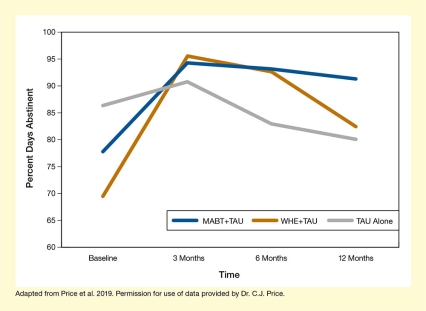This study reported:
- Mindful Awareness in Body-Oriented Therapy (MABT) improved emotion regulation, reduced craving, and promoted abstinence in women with a history of trauma and emotional problems receiving outpatient treatment for substance use disorder.
- Study participants who received MABT learned interoceptive skills and reported on their practice of these skills across the study year.
Women receiving treatment for substance use disorders (SUDs) often have previously experienced trauma and abuse, which may make it more difficult to control or regulate their emotions. These difficulties, in turn, increase their vulnerability to substance use. A recent study by Dr. Cynthia Price and colleagues at the University of Washington, Seattle, and the University of Utah found that Mindful Awareness in Body-Oriented Therapy (MABT)—a mindfulness-based treatment that specifically teaches patients interoceptive awareness skills—can improve abstinence and emotional health in these women. Notes Dr. Price, “This study is the first to demonstrate the efficacy of interoceptive awareness training in the treatment of SUD and related health outcomes.”
Interoception is the ability to access and evaluate sensations from inside the body and is important for emotion regulation. Tapping into internal sensations and increasing awareness may help people respond to physical sensations and emotions in a more positive way and cope more effectively with emotional problems. Dr. Price and her team tested whether this approach could help women in intensive outpatient SUD treatment to maintain abstinence and improve their emotional well-being and regulation. The study included 187 low-income women from three outpatient clinics who were treated primarily for misuse of stimulants, alcohol, and narcotics. They were randomly assigned to receive treatment as usual (TAU), TAU plus MABT, or TAU plus Women’s Health Education (WHE). The MABT and WHE interventions were both delivered individually once a week for 8 weeks. Women in the MABT group received specific instructions for building interoceptive awareness that they could practice at home, whereas women in the WHE group learned about such topics as reproductive health, nutrition, and cardiovascular health as part of a more general wellness strategy. Abstinence and various emotional and psychological measures were assessed at the beginning of the study and at 3, 6, and 12 months.
At 3 months, women who received MABT had fewer symptoms of depression and less craving, greater emotion regulation (as determined via self-report and psychophysiological assessments), and more interoceptive and mindfulness skills compared with the other study groups. At 6 months, women who had received either MABT or WHE in addition to TAU were more likely to remain abstinent than those receiving TAU alone. After 1 year, women who had received MABT still had high levels of abstinence, whereas the benefits of WHE had waned (see Figure). In addition, participants in the MABT group had maintained improvements at 12 months in craving and psychophysiological emotion regulation compared with women in the other two groups. Across the study year, women who received MABT reported continued use of interoceptive awareness skills in their daily lives.
Dr. Price and colleagues concluded that adding just 8 weeks of MABT to standard SUD treatment could induce sustained improvements in abstinence and improved regulation for these low-income patients with a history of trauma and emotional problems. Also, although 70% of the participants had received previous SUD treatment, at least half had never received mental health services. The researchers think that extending the MABT intervention or providing “booster” sessions and additional support may further improve outcomes for these vulnerable patients.
It is important to note study elements that limit the generalizability of the findings. For example, the majority (75%) of the participants were white, and the sample was women only. All participants had low socioeconomic status and reported substantial interpersonal trauma. Moreover, the results described above represent the findings from the participants who participated in at least six of eight of the MABT or WHE intervention sessions compared to TAU (n = 146). Nevertheless, Dr. Price says, “We are excited about the potential to help people gain new skills that they can incorporate into their daily lives to improve their well-being, particularly low-income and underserved populations such as the women in this study, who have such tremendous need for social support and mental health services due to co-occurring post-traumatic stress and substance use disorder.” She is now studying MABT as an adjunct to medication treatment for men and women with opioid use disorder.
This study was supported by NIDA grant DA033324.
- Text Description of Figure
The graph illustrates the level of abstinence achieved by women receiving TAU, TAU plus MABT, or TAU plus WHE. The horizontal x-axis indicates time from baseline to 12 months. The vertical y-axis indicates the percentage of days the participants were abstinent on a scale from 60% to 100%. The gray curve shows the results for women receiving TAU, the blue curve shows the results for women receiving TAU plus MABT, and the gold curve shows the results for women receiving TAU plus WHE. Women receiving TAU were abstinent on about 87% of days at baseline, about 90% of days at 3 months, about 82% of days at 6 months, and about 80% of days at 12 months. Women who received TAU plus MABT were abstinent on about 77% of days at baseline, about 95% of days at 30 months, about 94% of days at 6 months, and about 93% of days at 12 months. Women who received TAU plus WHE were abstinent on about 70% of days at baseline, about 96% of days at 3 months, about 93% of days at 6 months, and about 84% of days at 12 months.
Source:
- Price, C.J., Thompson, E.A., Crowell, S., and Pike, K. Longitudinal effects of interoceptive awareness training through mindful awareness in body-oriented therapy (MABT) as an adjunct to women’s substance use disorder treatment: A randomized controlled trial. Drug and Alcohol Dependence 198:140–149, 2019.

